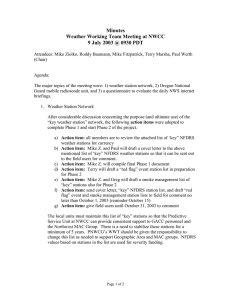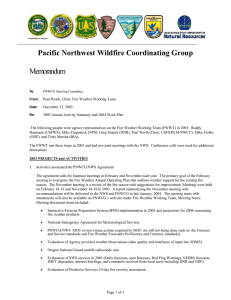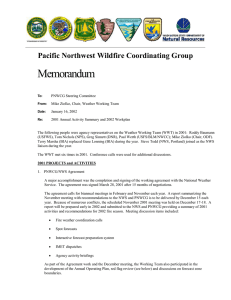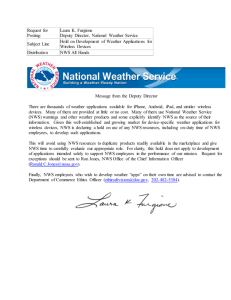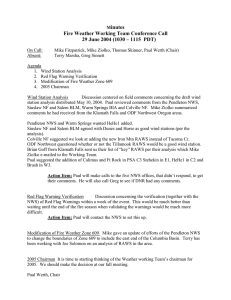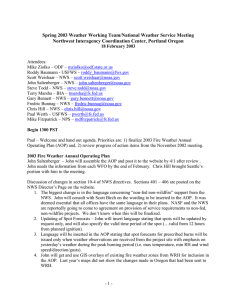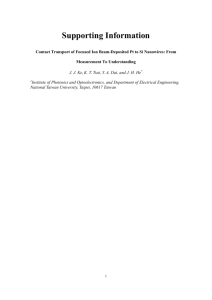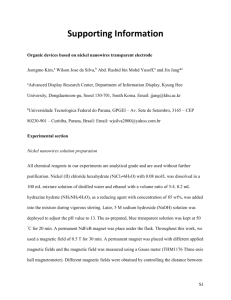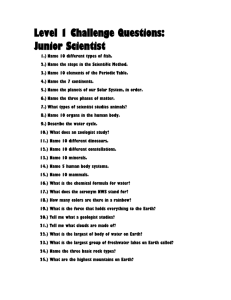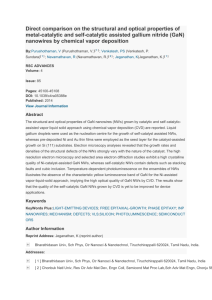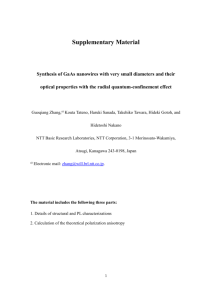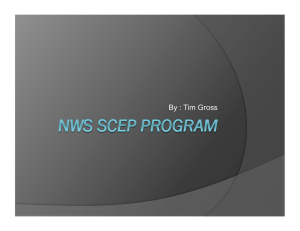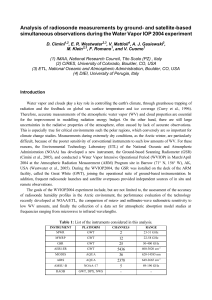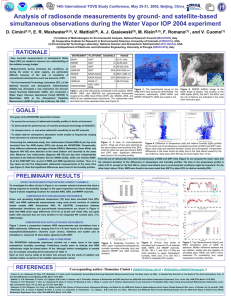Pacific Northwest Wildfire Coordinating Group Memorandum
advertisement
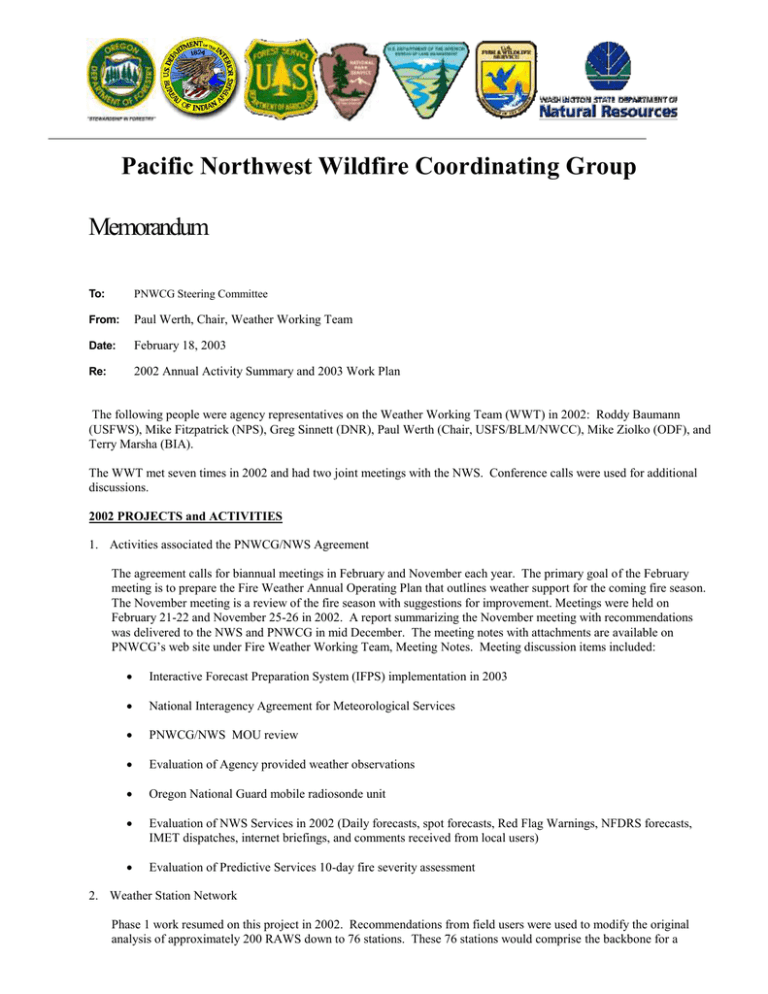
Pacific Northwest Wildfire Coordinating Group Memorandum To: PNWCG Steering Committee From: Paul Werth, Chair, Weather Working Team Date: February 18, 2003 Re: 2002 Annual Activity Summary and 2003 Work Plan The following people were agency representatives on the Weather Working Team (WWT) in 2002: Roddy Baumann (USFWS), Mike Fitzpatrick (NPS), Greg Sinnett (DNR), Paul Werth (Chair, USFS/BLM/NWCC), Mike Ziolko (ODF), and Terry Marsha (BIA). The WWT met seven times in 2002 and had two joint meetings with the NWS. Conference calls were used for additional discussions. 2002 PROJECTS and ACTIVITIES 1. Activities associated the PNWCG/NWS Agreement The agreement calls for biannual meetings in February and November each year. The primary goal of the February meeting is to prepare the Fire Weather Annual Operating Plan that outlines weather support for the coming fire season. The November meeting is a review of the fire season with suggestions for improvement. Meetings were held on February 21-22 and November 25-26 in 2002. A report summarizing the November meeting with recommendations was delivered to the NWS and PNWCG in mid December. The meeting notes with attachments are available on PNWCG’s web site under Fire Weather Working Team, Meeting Notes. Meeting discussion items included: Interactive Forecast Preparation System (IFPS) implementation in 2003 National Interagency Agreement for Meteorological Services PNWCG/NWS MOU review Evaluation of Agency provided weather observations Oregon National Guard mobile radiosonde unit Evaluation of NWS Services in 2002 (Daily forecasts, spot forecasts, Red Flag Warnings, NFDRS forecasts, IMET dispatches, internet briefings, and comments received from local users) Evaluation of Predictive Services 10-day fire severity assessment 2. Weather Station Network Phase 1 work resumed on this project in 2002. Recommendations from field users were used to modify the original analysis of approximately 200 RAWS down to 76 stations. These 76 stations would comprise the backbone for a Regional level NFDRS network in Oregon and Washington. The list will be transmitted to field offices for final comment. The report with recommendations will be submitted to PNWCG later this year for final approval completing Phase 1 of the project. 3. Fire Weather Zones NWS fire weather zone boundary changes were finalized in April after consultation with field units and the Weather Working Team. These zone boundary changes were used during the fire season. After the fire season, there were questions of zone boundaries in the Columbia Gorge, but these were resolved without additional zone boundary changes. The WWT’s position is that future boundary changes be coordinated through the WWT after inclusive analysis of fire, fuels and weather data. These new zone boundaries have been input into GIS and are available on the Internet. 4. National MOU with the NWS The Working Team provided input to NWCG regarding provisions of a national MOU with the NWS pertaining to fire weather services. Issues included: local agreements, the role of GACC meteorologists, and fire agency use of IMETs. 5. Deployment of Oregon National Guard mobile radiosonde unit to the Biscuit Fire A test deployment of the Oregon National Guard mobile radiosonde unit occurred in August on the Biscuit Fire. The purpose of the test was to determine the feasibility of using this unit on wildland fires in remote areas and the usefulness of the data produced. This unit has the capability to collect the same meteorological data as NWS radiosonde sites. It can measure the winds aloft, stability, and dryness of the air over the fire at any time day or night. This information is fed to the Incident Meteorologist and Fire Behavior Analysist for analysis and the making weather and fire behavior forecasts. Data produced by this unit is used to calculate the Haines Index over the fire, something that has never been done before. Firefighter safety and operational efficiency is definitely enhanced through the employment of this Oregon National Guard unit. 2003 Projected Work 1. NWCG/NWS biannual meetings The February biannual meeting will develop changes for 2003 operations that will be reflected in the Fire Weather Annual Operating Plan. The Operating Plan will be available by April 1 via the Internet. 2. Weather Station Network Phase 1 of the Regional level NFDRS backbone network will be completed this year with recommendations to PNWCG. Phase 2 will begin with focus on weather station needs for other activities such as smoke management, Red Flag event and verification, other fire management uses, and special projects. 3. Oregon National Guard mobile radiosonde unit Criteria will be developed with the Oregon National Guard and Oregon Department of Forestry concerning the deployment of the mobile radiosonde unit on wildland fires. The procedure for requesting the services of this unit will be detailed in “Ops Plan Smokey”. 4. Red Flag Criteria Work will continue to further refine red flag criteria for dry lightning situations and strong wind/low relative humidity. Verification work will continue in cooperation with the NWS on red flag issues. 5. PNWCG/NWS Agreement Further development, implementation and verification of products and services provided under the interagency agreement will continue. Periodic reports will be submitted to PNWCG. In general, the Working Team will also maintain contact with the National and California Wildfire Coordinating Groups on weather issues of mutual concern. Coordination and communications with other PNWCG working teams needs to be established and maintained.
